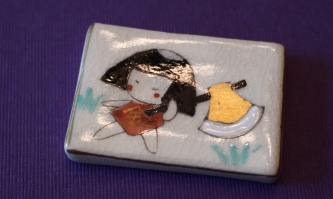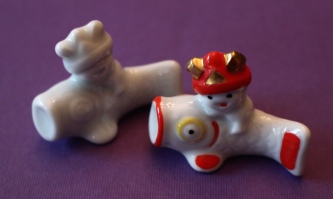My last entry in this series on Japanese folk heroes is a post about Kintarō, a sort of Japanese Hercules, a legendary figure who could dislodge boulders and uproot trees even as a child. His name means “golden boy,” and as a folk hero he is usually portrayed as a youngster wielding a hatchet and wearing a shirt decorated with the kanji for “gold,” as he is on the hashioki here.
youngster wielding a hatchet and wearing a shirt decorated with the kanji for “gold,” as he is on the hashioki here.
Kintarō is closely associated with Boy’s Day, the national Japanese holiday on the fifth day of the fifth month, or May 5. That is why he is often seen wearing a samurai’s kabuto helmet, and riding a koi no bori, the traditional carp kite or windsock that is  hung outside of houses with sons on that date. It is also customary to present Kintarō dolls to young boys on this holiday to inspire them to grow up to be as strong and brave as this folk hero.
hung outside of houses with sons on that date. It is also customary to present Kintarō dolls to young boys on this holiday to inspire them to grow up to be as strong and brave as this folk hero.
Kintarō was actually the childhood name of a historical person, a famous Heian period warrior named Sakata no Kintoki. Despite this provenance, he is reputed to be the son of a mountain woman, who grew up with wild beasts and imaginary creatures as his only playmates. Maybe that legend explains why a red-skinned, bare-chested Kintarō was a popular subject for ukiyoe artists during the Edo period (1), and why he continues to be featured in anime and manga to this day. There is even a traditional Japanese hard candy that bears his name.
(1) Baird, Merrily. Symbols of Japan: Thematic Motifs in Art and Design. New York: Rizzoli Publications, 2001, pp. 304-305.